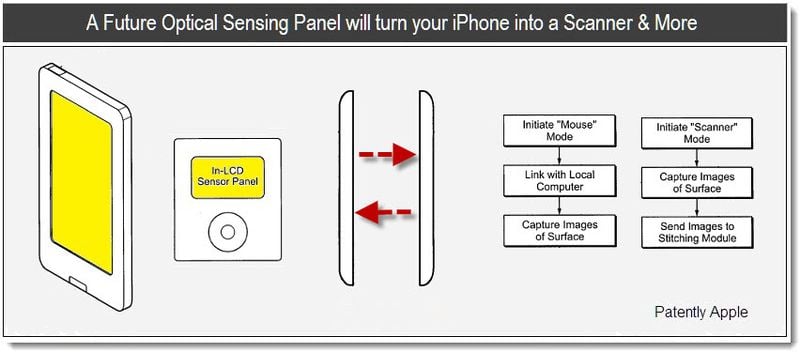Inginerii Apple lucreaza intens la dezvoltarea unor tehnologii dintre cele mai diverse iar un revent brevet de inventie inregistrat de Apple ne arata intentiile companiei de a produce display-uri optice care ar putea transforma un iPhone intr-un scanner. Aceste display-uri LCD ar permite transmiterea/receptarea de date prin intermediul unor senzori electromagnetici care scaneaza orice element plasat deasura ecranului, ii face o imagine pe care mai apoi o afiseaza pe ecran, sau pe care o poate transmite unui alt dispozitiv. HP a implementat o tehnologie asemanatoare in cele 3 produse prezentate aseara si se pare ca Apple are in plan sa imprumute ideile celor de la HP pentru urmatoarele iDevice-uri.
Configurations using optical in-LCD sensing panels could provide transmission and/or reception of data. In one transmit/receive configuration, an optical in-LCD sensing panel could be used for communication. Data is transmitted by displaying a communication image encoding the data on the sensing panel, and data is received by capturing, with the EM sensors embedded in the panel, a communication image displayed in proximity to the panel. In another configuration, data is received by scanning an object using an optical in-LCD sensing panel. The motion of a handheld device including the panel could be determined by scanning a surface with the EM sensors at different times and comparing the corresponding scan images.
Cei de la HP au implementat tehnologia NFC in produsele proprii si folosind-o cele 3 noi dispozitive pot interactiuna unul cu celalalt prin simpla apropiere. Apple intentioneaza sa faca exact acelasi lucru, insa compania va produce panouri LCD capabile sa scaneze materiale foto sau text plasate deasupra lor sau sa permita utilizatorului sa foloseasca ecranul pe post de touchpad pentru a controla mouse-ul unui calculator. Apple a brevetat o tehnologie extrem de interesanta insa ma indoiesc, ca o vom vedea in vreun produs prea curand.
In contrast to conventional handheld scanners, the foregoing example scanner mode may not require the user to maintain a constant velocity when moving the device across the surface to be scanned because, for example, the stitching algorithm can determine the motion of device 301 and compensate for the motion when stitching together the images.























